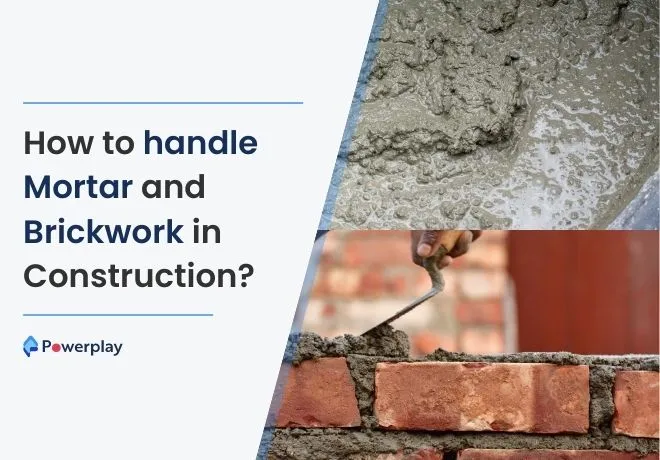How to handle Mortar and Brickwork in Construction?
-
Kumar Abhishek Anand
- October 23, 2023

A variety of grades of mortar, like M1, M2, and M3. are employed in the construction of bricks. Both cement and lime mortars are kinds of mortar commonly used for brickwork. These mortars’ properties, strengths, and applications in different situations should be understood.
What is Mortar?
Mortar is made up of cement and sand. If water gets added into the cement-sand mix and the cement is activated, it becomes to cure or becomes harder. As with concrete, mortar isn’t considered an extremely durable building material and could be used solely as a construction material. It functions more like “Glue” that keeps bricks, concrete, stones, concrete blocks, and other masonry materials together with a strong bond.
The binding material plays an essential part in the mortar process. Therefore, the mortar’s strength, durability, and longevity will depend on its quality and the quantity of binding material employed.
Mortar is typically available in bags and in a dry, pre-mixed form that can later be blended with water. The mortar mix can be made on-site with a shovel or hoe, a mixing tub, or a cement mixer. So the way to describe it is that mortar can be found in two varieties, the mortar that is wet and ready to use that doesn’t require mixing, and the Dry Mortar ready to use that requires the addition of water.
What are the functions of Mortar in Construction?
Mortar is used in construction and is typically required for masonry work, the plastering process, and pointing. However, it also serves a variety of important roles:
a. Binds together stones or bricks.
b. Gives strength to the structure.
c. It provides cohesion and force to the structure unit.
d. It is a crucial means of uniformly dispersing the force through the structure.
e. It provides additional strength and resistance against rain dispersion and other similar weathering organizations.
f. It is used to fill in gaps in stone or brick masonry. In general, a small amount of liquid mortar referred to as Grout is utilized.
Considerations for Mortar and Brickwork in Construction
The various considerations that need to be considered while using mortar in brickwork construction are:
1. Strength of the brick is not dependent on the grade of mortar, i.e. various mortar mixes with different types like M1 and M2 can have different strengths, but this doesn’t alter the strength of brickwork. For instance, mortars with mix ratios of 1:6 and 1;4 have the same strength as brickwork made of the same bricks. However, these are different in strength. So the strength of the brickwork depends on the strength and durability of the bricks.
2. If the cement mix proportion of 1:3 is used to create a cement to sand or (cement and lime) to sand ratio, it creates a strong mortar with fewer empty spaces.
3. Benefits from Lime Mortar. Although lime mortar’s strength is lower than that of cement mortar benefits of using lime Mortar are:
a. Shrinkage in Mortar is reduced, making it less prone to cracks caused by shrinkage.
b. lime enhances the working ability and flexibility in the mix.
c. lime has a high water retention capacity, and it does not disappear quickly. Dry bricks are unable to absorb water out of limestone mortar.
d. Lime expands the mortar size and fills in the voids, thereby making it more water-resistant. Thus, lime mortar offers more water resistance and greater water tightness against rain infiltration.
e. The bonding of lime mortar and bricks can be better.
f. The cement-lime Mortar has more flexibility and can withstand the normal movement that brick masonry undergoes without deforming. So cement lime mortar, generally speaking, is less prone to break than mortar.
4. Lime mortar builds strength gradually and has a lower final force than cement mortar. Lime mortar with hydraulic lime is stronger and has more initial strength. Lime mortar made of fat lime doesn’t set even in damp locations.
The properties of semi-hydraulic limestone are similar to those of fat and hydraulic lime mortars. If you are using fat lime, it is essential to utilize certain pozzolanic substances, like burned clay instead of sand, to increase mortar quality.
5. Cement-lime mortars made of a leaner mix between 1:4 and 1:8 are generally harsh, especially if the sand is rough and ungraded. Thus, plasticizers are recommended to increase the flexibility and workability of mortar.
6. The following elements affect the quality of cement mortar when it is the same proportion of sand and cement:
a. Grading of sand
b. sand’s fineness and coarseness
c. The roundness and angle of the particles of sand
The plasticity of cement mortar is also affected by the fineness of sand in the same proportion between cement and sand. Therefore, the plasticity of cement mortar could also be enhanced by increasing the amount of cement used; however, this makes mortar expensive.
The amount of water added should be enough to allow enough workability in the mix. It should differ based on the above three elements. If the above three elements result in the need for less water and the strength of the mortar will increase.
7. When the fineness of sand grows, it increases the ability of the cement-mortar mixture and the area of the sand, for which the requirement grows for water and cement to similar strength. If the amount of cement is not increased, the strength will be lower. This is because it will require more water to achieve the desired work. This will increase the ratio between cement and water, thus weakening the.
8. Curing is vital for getting the highest strength and obtaining the best cement layer on the sand particles.
9. Mortar with a mix ratio of 1:3 is not suitable for brickwork construction because of the high shrinkage, and there is no improvement in the strength of the masonry, although the mortar’s strength is increased.
When you use a strong mortar, cracks will be less and larger, while when using weak mortar, cracks will appear in thin hair cracks. The stress caused by the different movements of masonry caused by contraction, expansion and so on. can also be reduced with thin mortar since the mortar is weak and can easily absorb the changes.
Thus, when it is not required to use a strong mortar due to strength considerations, it is recommended that a weak mortar be utilized. Since lean mortar made of cement and sand can be harsh and pervious, making it less malleable and less flexible, It is recommended to use a composite mortar made of lime, cement and sand.
10. Lime-based mortars like lime mortar or cement-lime mortar provide greater strength to brickwork, with the same strength as cement mortar.
For instance, the Cement-Sand ratio of 1:1 has the strength of mortar at 30kg/cm 2, with brickwork strength of 5.5 kg/cm 2, compared to cement-lime, as well as the sand-mix ratio of 1:1:6 with mortar strength of 30kg/cm 2. It also is stronger than the brickwork’s strength at 7kg/cm 2.
11. The most frequent problems with mortar in brickwork construction are identified as:
a. Mixing in the wrong way
b. High water content
c. Bed that is thick and unnaturally thick
d. The brick has high suction and lower water retentiveness than mortar
e. Uneven joints
f. Voids found in vertical joints
g. Bricks dispersed after the laying
12. The excessively thick joints weaken the strength of brickwork.
13. The addition of pozzolana enhances its strength, making the mortar more resistant to attacks from chemicals.
Share
Kumar is a digital content professional with more than 2 years of experience in Blog writing, copywriting and scripting. His passion lies in the art of creating convincing content that plays a major role in converting leads for SAAS businesses.












